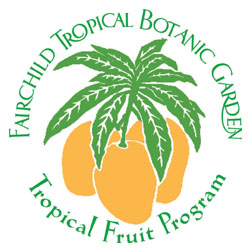
Other Tropical Fruit Trees
Fairchild Tropical Botanic Garden offers information about exciting cultivars of superior tropical fruit cultivars crafted by the Garden's horticultural staff to meet the needs of the South Florida home gardener. After you have sampled the refreshing drinks, milkshakes and other products possible with these fruit you will be a believer.
Before any tree is recommended, we have taken into account some key factors, such as:
- Proven adaptability to local soil and climate conditions.
- Appropriate size for space-limited, as well as, large residential lots.
- Advantages to homeowners; that is, what makes them so special?
Fairchild Tropical Botanic Garden is one of the only South Florida institutions with extensive scientific collections of tropical and subtropical fruit cultivars and flowering trees. For more information call: 305/667-1651, ext. 3413.
Longan
Dimocarpus longana
Longan is a lychee relative perfectly adapted to growth in South Florida. It is an impressive landscape tree with a dark green canopy and rounded shape. Grow it in full sun and with plenty of room, although pruning can be used to hold its size. 'Big Boy', a large fruited and flavorful longan selection, was discovered in Miami. Although it is not likely to fruit every year in our climate, its fruiting consistency to date has been encouraging.
Caimito
Chrysophyllum cainito
A satinleaf relative with tasty fruit.
Calabash
Crescentia cujete
Produces extremely large fruit.
Kwai muk
Artocarpus linganensis
Kwai muk is a jackfruit relative native to southern China. The beautiful, dark green tree is well suited to the home landscape, maturing at 15 to 20 feet tall. The golf ball-sized fruit ripen in the late summer. Their sweet/tart flavor is reminiscent of citrus.
Jocote
Spondias purpurea
Jocote is native to Central America where it has been grown as a traditional crop for centuries. After losing its leaves in the late winter, this small tree flowers and then produces a crop of sweet, juicy, red fruit. Jocote is easy to grow and will thrive in dry locations that are not irrigated. ‘Nicaragua Red', the Spanish plum or red mombin, forms an integral part of everyday life in tropical America. It is a superior large-fruited selection with excellent appearance and flavor. The flesh is orange, juicy and mildly acid. The tree stays small, and fits well into xeriscapes.
Persimmon
diospyros kaki
The tree is native to Japan, China and India. Fully ripe persimmons are usually eaten out of hand or cut in half and served with a spoon. The flesh may be added to salads, blended with ice cream or yoghurt, used in pancakes, gelatin desserts, pudding, mousse, jam or marmalade.
Pitomba
Eugenia luschnathiana
Pitomba, from Brazil, forms a small tree with narrow, dark-green leaves, and a spectacular peach colored trunk with peeling bark. The fruit are bright orange-yellow, about one inch in diameter, with a small seed. The fruit is excellent eaten out of hand or in preserves and juices.
White Sapote
Csaimiroa edulis
White sapote is native to Mexico and Central America. In South Florids, it is used as an ornamental and to attract wildlife. The giant swallowtail butterfly uses the tree as a host plant. The fruit, which are usually eaten fresh, also make a delicious flavoring for milk shakes and ice cream. They are eaten as a dessert with cream and sugar and can be used in fruit salad and sherbet.